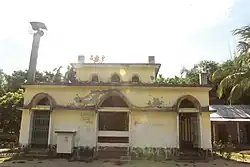Lalmonirhat Sadar
লালমনিরহাট সদর | |
|---|---|
 Majader Ara, possibly the oldest mosque in South Asia | |
.svg.png.webp) | |
| Coordinates: 25°54.9′N 89°27′E / 25.9150°N 89.450°E | |
| Country | |
| Division | Rangpur |
| District | Lalmonirhat |
| Headquarters | Lalmonirhat |
| Area | |
| • Total | 263.83 km2 (101.87 sq mi) |
| Population (2011) | |
| • Total | 333,166 |
| • Density | 1,300/km2 (3,300/sq mi) |
| Time zone | UTC+6 (BST) |
| Website | Official Map of Lalmonirhat Sadar |
Lalmonirhat Sadar (Bengali: লালমনিরহাট সদর) is an upazila of Lalmonirhat District[1] in the Division of Rangpur, Bangladesh. Its headquarters are in Lalmonirhat.
Geography
Lalmonirhat Sadar is located at 25°54′55″N 89°27′00″E / 25.9153°N 89.4500°E. It has a total area of 263.83 km2. Teesta River flows inside this upazila.
Demographics
| Year | Pop. (000) | ±% |
|---|---|---|
| 1981 | 212 | — |
| 1991 | 261 | +23.1% |
| 2001 | 289 | +10.7% |
| 2011 | 333 | +15.2% |
| 2022 | 373 | +12.0% |
| Source: Bangladesh Bureau of Statistics[2] | ||
According to the 2011 Bangladesh census, Lalmonirhat Sadar Upazila had 79,147 households and a population of 333,166. 78,228 (23.48%) were under 10 years of age. Lalmonirhat Sadar had a literacy rate (age 7 and over) of 47.37%, compared to the national average of 51.8%, and a sex ratio of 998 females per 1000 males. 60,322 (18.11%) lived in urban areas.[2][3]
As of the 1991 Bangladesh census, Lalmonirhat Sadar has a population of 260876. Males constitute are 51.52% of the population, and females 48.48%. This Upazila's eighteen up population is 131281. Lalmonirhat Sadar has an average literacy rate of 27.7% (7+ years), and the national average of 32.4% literate.[4]
Administration
Lalmonirhat Sadar Upazila is divided into Lalmonirhat Municipality and nine union parishads: Barobari, Gokunda, Harati, Khuniagachh, Kulaghat, Mogolhat, Mohendranagar, Panchagram, and Rajpur. The union parishads are subdivided into 117 mauzas and 173 villages.[2]
Lalmonirhat Municipality is subdivided into 9 wards and 64 mahallas.[2]
Education
There are 19 colleges in the upazila. They include honors level Lalmonirhat Government College.[1][5]
See also
References
- 1 2 Tanzimul Nayan (2012). "Lalmonirhat Sadar Upazila". In Sirajul Islam and Ahmed A. Jamal (ed.). Banglapedia: National Encyclopedia of Bangladesh (Second ed.). Asiatic Society of Bangladesh.
- 1 2 3 4 5 "Bangladesh Population and Housing Census 2011 Zila Report – Lalmonirhat" (PDF). bbs.gov.bd. Bangladesh Bureau of Statistics.
- ↑ "Community Tables: Lalmonirhat district" (PDF). bbs.gov.bd. Bangladesh Bureau of Statistics. 2011.
- ↑ "Population Census Wing, BBS". Archived from the original on 2005-03-27. Retrieved November 10, 2006.
- ↑ "List of Institutions". Ministry of Education. Retrieved July 15, 2014.
